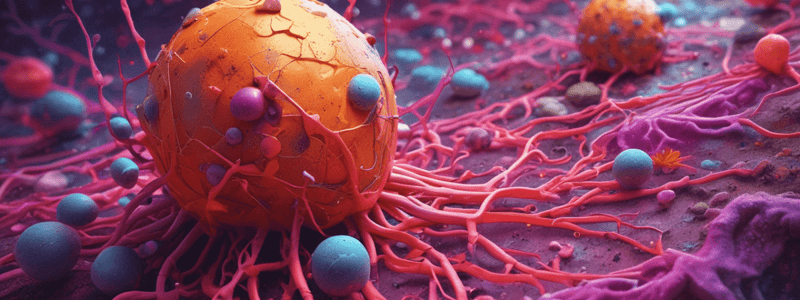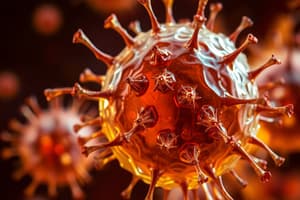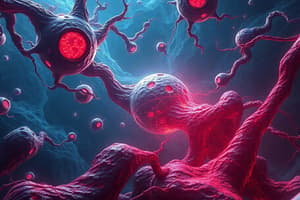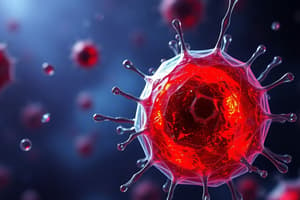Podcast
Questions and Answers
In which form of necrosis is the macroscopic appearance of the tissue liquid-like and sometimes creamy-yellow due to the presence of pus?
In which form of necrosis is the macroscopic appearance of the tissue liquid-like and sometimes creamy-yellow due to the presence of pus?
- Coagulative necrosis
- Extrinsic pathway
- Liquefactive necrosis (correct)
- Gangrenous necrosis
Which cell death process involves the cleavage of procaspase-8 into caspase-8?
Which cell death process involves the cleavage of procaspase-8 into caspase-8?
- Apoptosis (correct)
- Intrinsic pathway
- Necrosis
- Liquefactive necrosis
What triggers the extrinsic pathway of cell death?
What triggers the extrinsic pathway of cell death?
- Radiation
- High temperature
- Signal binding to death receptor transmembrane protein (correct)
- Exposure to toxins
Which form of necrosis is the predominant type in every organ except the brain and typically starts out pale and dry?
Which form of necrosis is the predominant type in every organ except the brain and typically starts out pale and dry?
Which type of cell death is characterized by DNA dissolution, condensation, and fragmentation, followed by plasma membrane rupture and inflammatory response activation?
Which type of cell death is characterized by DNA dissolution, condensation, and fragmentation, followed by plasma membrane rupture and inflammatory response activation?
Which type of necrosis is characterized by the accumulation of white, soft, cheesy-looking material as a result of macrophages partially digesting cells?
Which type of necrosis is characterized by the accumulation of white, soft, cheesy-looking material as a result of macrophages partially digesting cells?
What is the key difference between apoptosis and necrosis in terms of the cell death process?
What is the key difference between apoptosis and necrosis in terms of the cell death process?
Which type of necrosis is associated with the deposition of fibrin within blood vessels, often linked to vascular damage from autoimmune or immune-complex disorders?
Which type of necrosis is associated with the deposition of fibrin within blood vessels, often linked to vascular damage from autoimmune or immune-complex disorders?
What is the key mechanism behind the macroscopic appearance of severely darkened, dry skin with varying degrees of putrefaction seen in gas gangrene?
What is the key mechanism behind the macroscopic appearance of severely darkened, dry skin with varying degrees of putrefaction seen in gas gangrene?
Which type of necrosis is characterized by the formation of whitish deposits due to the generation of free fatty acids from the breakdown of lipids?
Which type of necrosis is characterized by the formation of whitish deposits due to the generation of free fatty acids from the breakdown of lipids?
What is the defining characteristic that distinguishes apoptosis from necrosis?
What is the defining characteristic that distinguishes apoptosis from necrosis?
Which pathway of apoptosis is triggered by the mitochondrial release of cytochrome C?
Which pathway of apoptosis is triggered by the mitochondrial release of cytochrome C?
What is a key feature of necrosis that is different from apoptosis?
What is a key feature of necrosis that is different from apoptosis?
In which type of necrosis does tissue appear as a liquid viscous mass?
In which type of necrosis does tissue appear as a liquid viscous mass?
Which process culminates in the activation of caspase-3?
Which process culminates in the activation of caspase-3?
What is the hallmark of the point of no-return in irreversible cell injury?
What is the hallmark of the point of no-return in irreversible cell injury?
What cellular change is associated with reversible cell injury?
What cellular change is associated with reversible cell injury?
Which cellular component is affected in liquefactive necrosis?
Which cellular component is affected in liquefactive necrosis?
In apoptosis, which pathway is initiated by intracellular signals resulting in cellular self-destruction?
In apoptosis, which pathway is initiated by intracellular signals resulting in cellular self-destruction?
What is a distinguishing feature of the extrinsic pathway in apoptosis?
What is a distinguishing feature of the extrinsic pathway in apoptosis?
Which type of cell adaptation involves an increase in the number of cells due to increased cell division, while the cells themselves appear normal?
Which type of cell adaptation involves an increase in the number of cells due to increased cell division, while the cells themselves appear normal?
Which type of cell adaptation involves a decrease in the size of cells, leading to a decrease in the size of the organ?
Which type of cell adaptation involves a decrease in the size of cells, leading to a decrease in the size of the organ?
Which type of cell death is characterized by the breakdown of the cell membrane, leading to the release of cellular contents and an inflammatory response?
Which type of cell death is characterized by the breakdown of the cell membrane, leading to the release of cellular contents and an inflammatory response?
Which pathway of cell death is initiated by the binding of death ligands to cell surface receptors?
Which pathway of cell death is initiated by the binding of death ligands to cell surface receptors?
Which type of necrosis is characterized by the liquefaction of the cell contents, leading to the formation of a fluid-filled cavity?
Which type of necrosis is characterized by the liquefaction of the cell contents, leading to the formation of a fluid-filled cavity?
Which pathway of cell death is initiated by the release of cytochrome c from the mitochondria?
Which pathway of cell death is initiated by the release of cytochrome c from the mitochondria?
Which type of cell adaptation involves an increase in the size of cells, leading to an increase in the size of the organ?
Which type of cell adaptation involves an increase in the size of cells, leading to an increase in the size of the organ?
Which type of cell death is characterized by the fragmentation of the cell and the formation of apoptotic bodies?
Which type of cell death is characterized by the fragmentation of the cell and the formation of apoptotic bodies?
Which type of cell adaptation involves the replacement of one cell type with another, more specialized cell type?
Which type of cell adaptation involves the replacement of one cell type with another, more specialized cell type?
Which type of necrosis is characterized by the coagulation of the cell contents, leading to the formation of a dry, granular mass?
Which type of necrosis is characterized by the coagulation of the cell contents, leading to the formation of a dry, granular mass?
What is the primary mechanism by which free radicals/reactive oxygen species (ROS) cause cell injury?
What is the primary mechanism by which free radicals/reactive oxygen species (ROS) cause cell injury?
Which of the following is NOT a source of free radicals/reactive oxygen species (ROS) production?
Which of the following is NOT a source of free radicals/reactive oxygen species (ROS) production?
In the intrinsic pathway of apoptosis, what is the primary initiating event?
In the intrinsic pathway of apoptosis, what is the primary initiating event?
Which of the following is a characteristic feature of liquefactive necrosis?
Which of the following is a characteristic feature of liquefactive necrosis?
In the extrinsic pathway of apoptosis, what is the primary initiating event?
In the extrinsic pathway of apoptosis, what is the primary initiating event?
Which of the following statements about apoptosis is correct?
Which of the following statements about apoptosis is correct?
What is the role of cytochrome c in the intrinsic pathway of apoptosis?
What is the role of cytochrome c in the intrinsic pathway of apoptosis?
Which of the following is a characteristic feature of necrosis, as opposed to apoptosis?
Which of the following is a characteristic feature of necrosis, as opposed to apoptosis?
What is the primary difference between the intrinsic and extrinsic pathways of apoptosis?
What is the primary difference between the intrinsic and extrinsic pathways of apoptosis?
Which of the following is a potential intracellular stimulus that can trigger the intrinsic pathway of apoptosis?
Which of the following is a potential intracellular stimulus that can trigger the intrinsic pathway of apoptosis?
What is the hallmark of the point of no-return in irreversible cell injury?
What is the hallmark of the point of no-return in irreversible cell injury?
Which of the following is a potential intracellular stimulus that can trigger the intrinsic pathway of apoptosis?
Which of the following is a potential intracellular stimulus that can trigger the intrinsic pathway of apoptosis?
What is the primary mechanism by which free radicals/reactive oxygen species (ROS) cause cell injury?
What is the primary mechanism by which free radicals/reactive oxygen species (ROS) cause cell injury?
Which type of cell adaptation involves an increase in the size of cells, leading to an increase in the size of the organ?
Which type of cell adaptation involves an increase in the size of cells, leading to an increase in the size of the organ?
Which physical/mechanical factor can contribute to cell injury?
Which physical/mechanical factor can contribute to cell injury?
Which cellular component is the primary target of heavy metal-induced cell injury?
Which cellular component is the primary target of heavy metal-induced cell injury?
Which of the following is the hallmark of the point of no-return in irreversible cell injury?
Which of the following is the hallmark of the point of no-return in irreversible cell injury?
Which cellular process is the primary target of free radical-mediated cell injury?
Which cellular process is the primary target of free radical-mediated cell injury?
Which type of physical/mechanical factor can lead to irreversible cell injury?
Which type of physical/mechanical factor can lead to irreversible cell injury?
Which of the following is a key cellular target of injurious stimuli that can lead to irreversible cell damage?
Which of the following is a key cellular target of injurious stimuli that can lead to irreversible cell damage?
Which of the following is NOT a cellular target of injurious stimuli that can lead to cell injury?
Which of the following is NOT a cellular target of injurious stimuli that can lead to cell injury?
Which of the following is NOT a source of free radicals or reactive oxygen species (ROS) production?
Which of the following is NOT a source of free radicals or reactive oxygen species (ROS) production?
Which of the following is a consequence of hypoxia that can lead to cell injury?
Which of the following is a consequence of hypoxia that can lead to cell injury?
Which of the following is a characteristic feature of cell necrosis, as opposed to apoptosis?
Which of the following is a characteristic feature of cell necrosis, as opposed to apoptosis?
Which of the following is a physical or mechanical factor that can contribute to cell injury?
Which of the following is a physical or mechanical factor that can contribute to cell injury?
What is the main outcome of apoptosis in terms of the plasma membrane?
What is the main outcome of apoptosis in terms of the plasma membrane?
Which molecule plays a key role in the intrinsic pathway of apoptosis by forming an apoptosome?
Which molecule plays a key role in the intrinsic pathway of apoptosis by forming an apoptosome?
What is the primary stimulus for initiating the intrinsic pathway of apoptosis?
What is the primary stimulus for initiating the intrinsic pathway of apoptosis?
Which cellular component is released into the cytoplasm in the intrinsic pathway of apoptosis?
Which cellular component is released into the cytoplasm in the intrinsic pathway of apoptosis?
How are apoptotic bodies ultimately disposed of in the process of apoptosis?
How are apoptotic bodies ultimately disposed of in the process of apoptosis?
What is the primary sign associated with acute superficial thrombophlebitis?
What is the primary sign associated with acute superficial thrombophlebitis?
Which of the following is a key sign of chronic venous insufficiency?
Which of the following is a key sign of chronic venous insufficiency?
What is the primary symptom associated with varicose veins?
What is the primary symptom associated with varicose veins?
What is the most concerning sign that would indicate a deep vein thrombosis (DVT) emergency?
What is the most concerning sign that would indicate a deep vein thrombosis (DVT) emergency?
Which of the following is a key sign of venous insufficiency that can be observed during the physical exam?
Which of the following is a key sign of venous insufficiency that can be observed during the physical exam?
What is the most common cause of acute superficial thrombophlebitis?
What is the most common cause of acute superficial thrombophlebitis?
What is the primary risk factor for the development of chronic venous insufficiency?
What is the primary risk factor for the development of chronic venous insufficiency?
Which of the following is a key sign of arterial insufficiency?
Which of the following is a key sign of arterial insufficiency?
What is the primary purpose of the Homan sign test in assessing deep vein thrombosis (DVT)?
What is the primary purpose of the Homan sign test in assessing deep vein thrombosis (DVT)?
What does the Allen test primarily assess for in the upper extremities?
What does the Allen test primarily assess for in the upper extremities?
Which of the following would be a significant finding when observing postural color changes related to chronic arterial insufficiency?
Which of the following would be a significant finding when observing postural color changes related to chronic arterial insufficiency?
What is the main difference between arterial pain and venous pain as described in the text?
What is the main difference between arterial pain and venous pain as described in the text?
Which of the following accurately describes a characteristic difference between arterial and venous pain intensity?
Which of the following accurately describes a characteristic difference between arterial and venous pain intensity?
What is one of the key differences in symptoms when comparing acute arterial and venous insufficiency?
What is one of the key differences in symptoms when comparing acute arterial and venous insufficiency?
In assessing patients with suspected DVT, what does a >1cm difference in calf measurements bilaterally suggest?
In assessing patients with suspected DVT, what does a >1cm difference in calf measurements bilaterally suggest?
When observing postural color changes associated with chronic arterial insufficiency, what should happen if the legs are raised to 60°?
When observing postural color changes associated with chronic arterial insufficiency, what should happen if the legs are raised to 60°?
Which of the following is the most accurate method for assessing jugular venous pressure (JVP)?
Which of the following is the most accurate method for assessing jugular venous pressure (JVP)?
What is the clinical significance of a JVP measurement of 9 cm or more?
What is the clinical significance of a JVP measurement of 9 cm or more?
Which of the following is a characteristic finding in chronic arterial insufficiency?
Which of the following is a characteristic finding in chronic arterial insufficiency?
Which of the following is a potential sign of acute arterial occlusion, which is considered an emergency?
Which of the following is a potential sign of acute arterial occlusion, which is considered an emergency?
When documenting jugular venous pressure (JVP) in a SOAP note, which of the following formats is recommended?
When documenting jugular venous pressure (JVP) in a SOAP note, which of the following formats is recommended?
What is the formula for estimating central venous pressure (CVP) without a central line, based on the jugular venous pressure (JVP) measurement?
What is the formula for estimating central venous pressure (CVP) without a central line, based on the jugular venous pressure (JVP) measurement?
Which of the following is a potential sign or symptom of chronic arterial insufficiency?
Which of the following is a potential sign or symptom of chronic arterial insufficiency?
Which of the following techniques is used to distinguish venous from arterial pulsations during the assessment of jugular venous pressure (JVP)?
Which of the following techniques is used to distinguish venous from arterial pulsations during the assessment of jugular venous pressure (JVP)?
When assessing for edema in a patient, which of the following techniques should be used?
When assessing for edema in a patient, which of the following techniques should be used?
When palpating peripheral arterial pulses, which of the following statements is correct?
When palpating peripheral arterial pulses, which of the following statements is correct?
When inspecting the extremities, which of the following findings would be considered abnormal?
When inspecting the extremities, which of the following findings would be considered abnormal?
When assessing the temperature of the extremities, which of the following statements is correct?
When assessing the temperature of the extremities, which of the following statements is correct?
Which of the following skin abnormalities would be of concern when inspecting the extremities?
Which of the following skin abnormalities would be of concern when inspecting the extremities?
When assessing for edema in a bedridden patient, which area should be specifically examined?
When assessing for edema in a bedridden patient, which area should be specifically examined?
When grading peripheral arterial pulses, which of the following descriptions corresponds to a grade of 4?
When grading peripheral arterial pulses, which of the following descriptions corresponds to a grade of 4?
When documenting the assessment of peripheral pulses, which of the following statements is correct?
When documenting the assessment of peripheral pulses, which of the following statements is correct?
Which of the following is the primary difference between JVD and JVP?
Which of the following is the primary difference between JVD and JVP?
What is the primary purpose of assessing jugular venous pulsations (JVP)?
What is the primary purpose of assessing jugular venous pulsations (JVP)?
Where is the area over the internal jugular vein that is observed for fluttering movement?
Where is the area over the internal jugular vein that is observed for fluttering movement?
What is the key difference between jugular venous pulsations (JVP) and the carotid pulse?
What is the key difference between jugular venous pulsations (JVP) and the carotid pulse?
Which of the following is a key factor that can lead to an increase in venous pressure?
Which of the following is a key factor that can lead to an increase in venous pressure?
What is the primary anatomical landmark used to assess jugular venous distension (JVD)?
What is the primary anatomical landmark used to assess jugular venous distension (JVD)?
What is the primary clinical significance of assessing jugular venous distension (JVD)?
What is the primary clinical significance of assessing jugular venous distension (JVD)?




